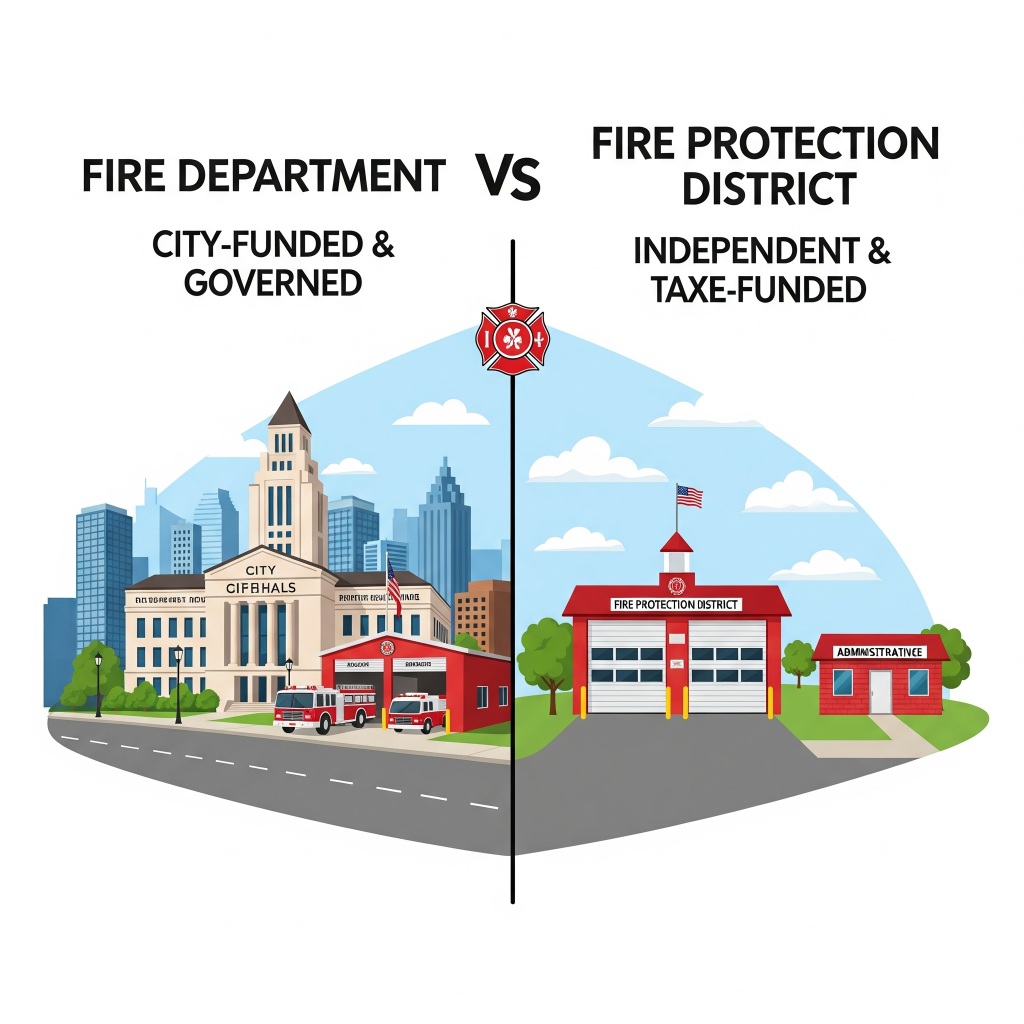
Fire safety is a paramount concern for communities worldwide, and the entities responsible for ensuring it vary in structure and scope. Two common terms often used interchangeably are “fire department” and “fire protection district.” However, despite their shared goal of safeguarding lives and property, there are fundamental differences between the two. In this article, we delve into the nuances that distinguish a fire department from a fire protection district, shedding light on their roles, functions, and the unique contributions each makes to community safety.
Defining a Fire Department
Structural Framework
A fire department is typically a municipal or county-level organization tasked with providing fire suppression, rescue services, and emergency medical response within a defined jurisdiction. It operates under the governance of the local government and is funded through municipal budgets, taxes, or a combination of both.
Personnel and Equipment
Fire departments consist of professional firefighters and support staff. The personnel are often career firefighters who receive compensation for their services. Fire departments are equipped with specialized vehicles, firefighting apparatus, and advanced equipment to respond swiftly to emergencies.
Scope of Services
Fire departments offer a comprehensive range of services, including firefighting, hazardous materials response, technical rescues, and emergency medical services. They are on standby 24/7, ready to respond to various incidents and emergencies within their designated area.
Understanding a Fire Protection District
Jurisdictional Autonomy
A fire protection district, on the other hand, is a distinct legal entity separate from municipal or county governance. It operates as an independent taxing authority, with the ability to levy taxes within its defined boundaries to fund its operations. The establishment of a fire protection district often involves community referendums and legislative approval.
Governance and Decision-Making
Fire protection districts are governed by an elected board of directors or trustees. This elected body is responsible for making decisions regarding the district’s budget, policies, and operational strategies. The level of autonomy granted to fire protection districts can vary based on local laws and regulations.
Funding Mechanism
Unlike fire departments, which rely on municipal budgets, fire protection districts generate revenue primarily through property taxes imposed on the residents within their jurisdiction. This dedicated funding source allows them to maintain financial stability and plan for long-term initiatives.
Key Differences in Operation
Here’s a comparison table outlining the key differences between a Fire Department and a Fire Protection District:
| Feature | Fire Department | Fire Protection District |
|---|---|---|
| Definition | A government agency providing fire and emergency services within a specific municipality. | A designated area established to provide fire protection services to multiple communities or regions. |
| Organizational Structure | Typically hierarchical with a chief and various ranks, including full-time, part-time, and volunteer personnel. | Often governed by an elected or appointed board of directors, with leadership provided by a fire chief and primarily volunteer personnel. |
| Funding and Budget | Funded through municipal budgets, property taxes, and local government income. | Funded through property taxes and special assessments specific to the district. |
| Geographic Coverage | Serves a specific city or township, with potential mutual aid agreements for extended coverage. | Covers a designated area that may include multiple towns or unincorporated regions. |
| Level of Service | May offer a broad range of services, including advanced life support, HAZMAT response, and fire prevention programs. | Typically focuses on fire suppression and basic emergency services, especially in smaller or rural districts. |
| Community Engagement | Engages in educational programs, fire prevention initiatives, and building community trust. | Emphasizes community involvement through local boards and outreach efforts for fire safety education. |
| Staffing | Often employs full-time personnel for quick response times; may include volunteers in smaller departments. | Reliant on volunteer firefighters, especially in rural areas, with fewer paid staff members. |
| Response to Emergencies | Rapid response due to full-time staffing during peak hours. | Response times may vary based on staffing levels and volunteer availability. |
This table summarizes the essential distinctions between fire departments and fire protection districts, providing a clear overview of their roles, structures, and functions.
Service Delivery Models
While both entities aim to ensure public safety, their service delivery models differ. Fire departments often operate with a centralized approach, providing services directly to the community. In contrast, fire protection districts may contract with a fire department or establish their own services, influencing the degree of control they have over operations.
Budgetary Independence
A significant distinction lies in the financial autonomy of fire protection districts. Their ability to levy taxes independently allows for a more predictable and stable funding stream, reducing reliance on external sources. Fire departments, conversely, are subject to the budgetary decisions of local government officials.
Community Engagement
Fire protection districts may foster a greater sense of community involvement due to their localized governance structure. Residents often have a direct say in district affairs through participation in board elections and public meetings. Fire departments, while responsive to community needs, may have decision-making processes that are less directly influenced by the public.
Collaborative Efforts for Enhanced Safety
Mutual Aid Agreements
Despite their differences, fire departments and fire protection districts recognize the importance of collaboration. Mutual aid agreements are common, allowing entities to share resources, personnel, and expertise during large-scale incidents or emergencies that exceed individual capacities.
Training and Standards
Both entities adhere to standardized training programs and safety protocols established at regional, national, or international levels. This ensures a uniform approach to firefighting, rescue operations, and emergency medical services, regardless of organizational structure.
Addressing Community-Specific Needs
Tailored Solutions
The distinction between a fire department and a fire protection district allows communities to adopt an organizational structure that best addresses their specific needs and preferences. Urban areas may prefer the centralized control and efficiency of a fire department, while rural or suburban areas might find the autonomy and local governance of a fire protection district more suitable.
Adaptability to Growth
Fire protection districts, with their independent funding mechanisms, may be better equipped to adapt to population growth and changes in the community. They can adjust tax rates or seek voter-approved increases to secure the necessary resources for expanded services.
Conclusion: A Unified Mission for Safety
In conclusion, the terms “fire department” and “fire protection district” represent distinct organizational structures, each with its unique attributes. Understanding these differences is crucial for communities as they strive to create effective and resilient systems for ensuring public safety.
While a fire department operates under the umbrella of local government, relying on municipal budgets and taxes, a fire protection district stands as an independent taxing authority. The autonomy granted to fire protection districts in financial matters allows for a more direct response to the needs of the community they serve.
In practice, these entities share a common goal: safeguarding lives and property. Whether through a fire department’s centralized service delivery or a fire protection district’s localized governance, the commitment to public safety remains unwavering. As communities evolve, the flexibility of these organizational structures ensures that safety measures can adapt to changing needs.
FAQs About Fire Departments and Protection Districts
- Q: Can a fire department and a fire protection district exist in the same area?
- A: Yes, it is possible for both entities to coexist in the same region. They may collaborate through mutual aid agreements, providing a layered approach to emergency services.
- Q: Are volunteer firefighters common in both fire departments and fire protection districts?
- A: Yes, both entities may have volunteer firefighters in addition to career personnel. Volunteerism plays a crucial role in augmenting emergency response capabilities.
- Q: How do funding challenges impact the services provided by fire departments and fire protection districts?
- A: Funding challenges can impact the scope and quality of services. Fire departments may face budget constraints tied to municipal finances, while fire protection districts rely heavily on property tax revenues.
- Q: Can residents influence decisions made by a fire protection district’s board of directors?
- A: Yes, residents typically have the opportunity to influence decisions through participating in elections for the board of directors and voicing their concerns during public meetings.
- Q: How do fire departments and fire protection districts plan for future growth in their communities?
- A: Fire departments may work closely with municipal planners, while fire protection districts can adjust tax rates or seek voter-approved increases to ensure they have the necessary resources to address the growing needs of the community.
